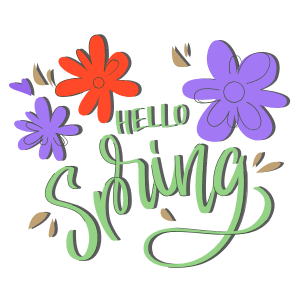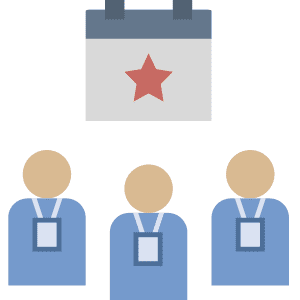Seasonal demand in business affects several industries. Back-to-School season from August to September is second only to the Holiday Season from late November to the end of December in retail sales. In the United States, Black Friday, the Friday after Thanksgiving, is the first unofficial shopping day of the holiday season. So-called because the increased shopping traffic is thought to result in stores making their first-year profit, sending their accounting statistics from the red to the black.

Event planning seasonal trends are comparable. Certain times of the year have been identified as showing clear upward trends. This time frame becomes critical for event planners who want to plan and reserve locations as soon as possible. This blog will explore seasonal demand patterns in the events planning industry to provide event planners and venue providers with tips on efficiently managing seasonal demand.
What is Seasonal Demand?
Seasonal demand refers to a time series characterized by regular or predictable demand patterns caused by recurring seasonal occurrences. These cycles might reoccur over days, weeks, months, or quarters, making it difficult for firms to accurately forecast demand.
Why are employers concerned about seasonal demand if it is impossible to predict? This is because employers frequently seek to forecast seasonal demand to discover variations in customer requirements and areas of concern for their firm. Seasonal demand forecasting is critical, particularly in the events industry, where the market is continuously changing, and competition is increasing. Our next point will look at recognizing general trends that occur in event planning.
General Seasonal Demand Trends in Event Planning
Most event planners already have an idea of what the peak seasons are. Customer demand is known to spike are specific times in different industries. Black Friday in retail is a perfect example of this, and there is generally sales data there to back it up.
But if you’re new to this demand planning, this section is for you! Let’s take a little look at seasonality patterns that event planners typically work with.

SPRING in demand
As winter gives way to spring, event planning becomes a little hectic. Spring is a lively time for event management. There are more activities like weddings, corporate retreats, and outdoor festivals. Seasonal celebrations, such as Easter and St. Patrick’s Day, also take place during this time.
To meet the unique demands of this period, accurate demand forecasts are crucial for event planners to ensure seamless execution and customer satisfaction.
Anticipating Seasonal Trends
Spring events often lean towards outdoor venues, floral themes, and fresh, seasonal menus. As an event planner, it’s important to anticipate these preferences and collaborate with vendors early to secure supplies like floral arrangements, catering services, and outdoor equipment rentals. Research trends in event design and decor for spring to stay ahead of client expectations.
Back to Work…for now!

While summer is a busy season for many event planners, incoming inquiries decrease slightly while people are away at events or on vacation. However, event planning sees a minor increase in September and October once the summer season is finished.
This period can be referred to as the Holiday Planning Season. Children have returned to school, parents have returned to work, and many businesses have begun to plan for year-end celebrations. Requests for holiday party planning stream in over these two months, giving excitement to event planners looking to fill their calendars for the end of the year.
No Time to Rest
When the holiday season begins, the amount of planning reduces, and event planners focus on producing unique holiday events. But, even before the last holiday party is cleaned away, the first requests of the New Year begin to stream in.
The month of January is the busiest for event planning. The New Year brings new corporate budgets, resolutions, and newly engaged couples planning their weddings. There are several reasons to arrange an event in the future year.
The meeting, wedding, and party requests quadrupled in January compared to the previous month.
Likely Seasonal Demand Trends for 2025 and after
The evolving landscape of event planning in 2025 highlights several key trends shaping the demand for venues. Event planners who align with these trends can secure prime locations, cater to client preferences, and deliver exceptional experiences.
Focus on Sustainability
Studies show that almost 50% of delegates are willing to pay extra to attend greener events. Organisers are recognising the benefits of sustainability when it comes to running events.
researchgate
Sustainability remains a significant priority for clients, influencing their choice of event venues. Eco-friendly locations that implement green initiatives such as renewable energy, waste reduction programs, and sustainable catering options are in high demand. Venues that demonstrate a commitment to environmental responsibility are not only appealing but also align with broader societal values, making them a preferred choice for many events

Outdoor and Scenic Venues
Natural settings such as gardens, vineyards, and waterfronts are increasingly popular as clients seek venues that provide a scenic backdrop and integrate with outdoor themes. These venues are particularly appealing for events that emphasize elegance and simplicity, offering a unique atmosphere that resonates with attendees.
Hybrid Ready Spaces
With hybrid events gaining momentum, venues equipped with advanced technology infrastructure are becoming essential. Spaces that offer robust internet connectivity, built-in audiovisual capabilities, and seamless integration for virtual participation are particularly attractive for conferences, corporate events, and large gatherings. Hybrid-ready venues ensure event accessibility for both in-person and remote audiences in real time.
Multi-functional Flexibility
Flexibility in venue layouts and uses is a critical demand in 2025. Clients favor spaces that can adapt to diverse event formats, from formal ceremonies to casual social gatherings. Venues offering customizable packages, modular setups, and versatile indoor-outdoor transitions are particularly valued for their ability to meet varied needs.
Smaller, Intimate Spaces
As personalized experiences remain a priority, smaller venues with intimate settings are gaining popularity. These spaces allow for custom layouts and tailored decor, making them ideal for weddings, private parties, and exclusive corporate events. Intimate venues provide a sense of connection and exclusivity that many clients seek.
Technology-Driven Innovation

Venues that embrace technological advancements are standing out in the competitive event landscape. From integrated lighting and sound systems to augmented reality (AR) and virtual reality (VR) capabilities, tech-enhanced venues offer dynamic and engaging experiences that elevate events to the next level.
By recognizing and leveraging these trends, event planners can secure venues that not only meet but exceed client expectations, ensuring successful and memorable events in 2025.
Managing Seasonal Demand Changes as an Event Planner
Recognizing seasonal demand variations is insufficient for event planning. Businesses must search for methods to improve their services, get ahead in planning, and outperform their competition. So, how do you stay up with the changes? Here are a few ways to align your offers with the seasons.
- Rethink your budget to account for the resurgence of in-person events. Reserve venues and event services as soon as possible.
- Avoid burnout for yourself and your employees. Hire enough people during high seasons. Spend your off-season developing solid relationships.
- Every event should be risk-assessed—plan for safety and budget for it. Have a backup plan in place for significant incidents.
- Find your planning style’s ideal augmented reality experience and keep current on developing event technology.
- Examine the ROI of your virtual event. With the new software, you can host better virtual and hybrid events in 2022.
- Reduce. Reuse. Recycle. Create a circular economy by using things that can be reused or recycled after an event. Add social value by donating or providing free courses and lectures to community members.
- Use staff scheduling software like Celayix to automate time-consuming processes like employee scheduling.
Managing Seasonal Demand Changes as a Venue Provider.
Venue providers often work side-by-side with event planners. They must keep in mind that the seasonal demand changes for event planning go hand-in-hand with their services. Nonetheless, there are a couple of things venue providers can do separately to ensure they are effectively managing seasonal demand.

- Prepare for a busy year. Examine your booking and cancellation rules to ensure that your calendar is entirely yet appropriately filled. Determine how much flexibility you are willing to offer.
- Give potential workers compelling reasons to join your company and even more compelling reasons to stay. Treat people well, pay enough remuneration, provide benefits, and foster a positive employee culture.
- Provide secure and sanitary event facilities, flexible booking regulations, and show planners your methods.
- Include augmented reality in your marketing strategy. Make a video tour of your facility to attract event planners and experts.
- Incorporate hybrid event marketing into your venue’s sales plan for 2025.
- Integrate or revitalize sustainability programmes.
Final Thoughts
Throughout the year, the event industry will likely see different kinds of events: Fundraisers, Camps, Reunions, Classes, Tournaments, Festivals, and Celebrations. Event planners and venue providers must use seasonal demand forecasting to optimize their competitiveness and plan.
One of the best ways to do this is by using software that helps create forecasts and help you decide. Managing seasonal demand can be straightforward if you have scheduling software such as Celayix that would help create the perfect schedule. You wouldn’t ever have to worry about being understaffed or overstaffed for any shift.
Marketing and communication are easier now because of new technology. The events venue industry should use this to handle the growing demand. In case you’d like to know more about managing venue staff, read our blogs on the essential skills to have for event success.





